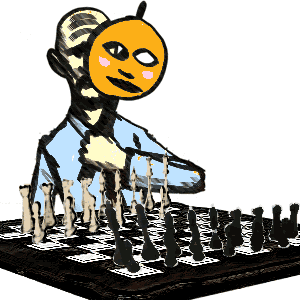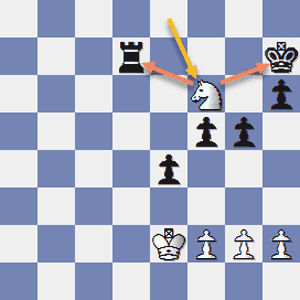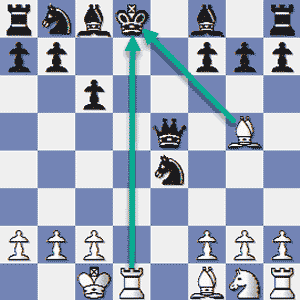Improve Chess Tactics - Burn the Enemy

Improve Chess Tactics: Can you hide your real intentions and spring a surprise tactical combination
The most common tactical motifs are the fork, the pin, the skewer, the discovered attack and the double check. These can be used on their own in a single move or in conjunction with each other in a combination.
As we set up we think about getting organized positionally. We make sure we're not vulnerable to danger. Then we have to think about turning the tide in our favor. We turn to tactics to get a decisive advantage in the game.
The Deadly Art of the Fork

Tactical Combinations: (Anand - Polgar, 1997) After a game littered with tactical threats, Anand puts together a combination that forces a position where he can win by means of the fork with 61.Nf6+. This leads to resignation from Black 11 moves later.
You may be able to round off a combination by attacking two pieces at once. Your opponent can only keep one of them, he will save the more valuable one. Then you take the remaining piece.
The reason that the Knight is especially adept at this is probably it's unique move. The Knight can attack two pieces without being vulnerable to capture from his targets.
Paralyze Your Opponents with the Pin

Improve Chess Tactics: (Kasparov - Deep Blue, 1996) With 28...Qf6, Kasparov ensnares the Knight in a double pin and wins the game using the demobilizing effects of this on White's pieces
If the pinned piece needs the King's protection he can't very well castle can he? Other defenders see their mobility reduced if they have to guard a pinned piece. This can all lead to paralysis in some cases.
You can also benefit directly from a pinning a piece. If a minor piece is pinned to a King or Queen, you can pile up attackers on it. If you manage to get more forces attacking the piece you can take it.
Line Them Up for the Skewer

Improve Chess Tactics: (Atalik - Buono, 2005) 62.Qh1+ wins a crazy game for White, capturing the Rook with the skewer
The skewer is the reverse of the pin. This time the piece in front is the more valuable unit and must move to escape capture. When it does the path is cleared for the attacking piece to capture the second piece that was standing behind.
This technique can also be used to gain positional dominance. Instead of capturing a lesser piece behind the attacked piece, your goal could be to gain access to a key square formerly blocked by the target. When it is moved your piece can be posted on the newly conquered point.
The Joy of the Discovered Attack

Improve Chess Tactics: (Nakamura - Shabalov, 2005) 23.Nd5 opens up an attack by the Bishop on the Queen who has nowhere to go
You have a Rook or Queen on a file or a Bishop or Queen on a diagonal that has an x-ray attack on a loose enemy piece. This attack is blocked only by one of your pieces standing between the two.
Your piece blocking the attack can move with tempo creating a second threat. Your opponent is only able to parry the more serious threat and you can collect the remaining bounty.
Freeze the Enemy in the Double Check

Improve Chess Tactics: (Reti - Tartakower, 1910) 10.Bg5! is a double check and it's checkmate next move
It could also win you material if your move also attacks other pieces, maybe the Queen. Your opponent's forces are completely vulnerable to whatever attack you can pose while activating the double check.
This motif can help you in a number of ways. Maybe forcing checkmate, winning material or just winning a tempo to bring another piece into the attack.
Put it All Together in a Combination
Improve Chess Tactics: (Rosanes - Anderssen, 1863) Having employed a number of tactical ideas Black ends the contest with 23...Re1#
When you put together tactical combinations of two, three, four or several moves, you often blend all kinds of tactics together. You pose double or multiple threats with each move, forcing your opponent into more and more trouble.
You can put together combinations featuring discovered attacks, double checks, piece sacrifices and pins that culminate in a skewer or a fork if not checkmate.
Moving On
Tactical Combinations: (Sicilian Defense, Classical Scheveningen) This is one of many positions in opening theory that you will become familiar with in your chess journey
There are several more forms. You could do worse than to start with these ones and recognize the patterns when you can use them. Put together a Study Plan and work on them regularly. Then put them into practice in your games.
Okay you're up and running with your positional game and your tactical shots. If you want to use them you have to get out of the openings in one piece. Now it's time to build your opening repertoire.






